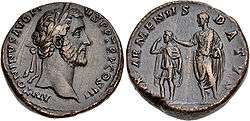Sohaemus of Armenia
Gaius Julius Sohaemus[1] (Greek: Γάϊος Ἰούλιος Σόαιμος) (died 180) was a Roman client king of Armenia.
| Sohaemus of Armenia | |
|---|---|
 Coin of Antoninus Pius, struck at the Rome mint, dated ca. 141-143. On the reverse, a standing Pius is depicted, holding roll and placing hand on head of Roman-appointed king of Armenia Sohaemus, who raises hand to adjust tiara. | |
| King of Armenia | |
| 1st Reign | 144–161 |
| Predecessor | Vologases I |
| Successor | Pacorus |
| 2nd Reign | 163–180 |
| Predecessor | Pacorus |
| Successor | Vologases II |
| Died | 180 |
Life
Sohaemus was a prominent person in the Roman Empire in the 2nd century from the Orontid dynasty of Commagene and the Emesene dynasty from Syria.[2][3] The novelist of the 2nd century, his contemporary Iamblichus[3] claims Sohaemus as his fellow-countryman.[1] Iamblichus calls Sohaemus as an Arsacid and Achaemenid, in his lineage. He was a descendant of the Median Princess Iotapa, who was once betrothed to the Ptolemaic Prince Alexander Helios.[4] Little is known about Sohaemus’ family and early life prior to becoming King of Armenia.[5] Before becoming King, Sohaemus had been a Roman Senator and served as a Consul in Rome at an unknown date.[4]
In 144, Sohaemus received the Armenian throne from the Roman emperor Antoninus Pius after the overthrow of Vologases I. In honor of his first ascent to the throne of Armenia, a copper medal with images of Sohaemus and Antoninus Pius was issued in Rome with the inscription "King of Armenians granted by decision of the Senate". Sohaemus was a contemporary to the rule of the Roman emperors: Antoninus Pius, Marcus Aurelius, Lucius Verus and Commodus of the Nerva–Antonine dynasty. In the first reign, he ruled from the year 144 until 161. Not much is known about his first reign. The novelist Iamblichus living in Armenia at the time of his rule describes his reign as ‘in succession to his ancestors’.[3] This statement can also refer to his former ancestor Sohaemus of Emesa who lived in the 1st century.[3]
In 161 Vologases IV of Parthia, son of the legitimate King Mithridates IV of Parthia, dispatched his troops to seize Armenia and eradicated the Roman legions stationed in the country under the legatus Marcus Sedatius Severianus. Encouraged by the Spahbod Osroes, Parthian troops marched further West into Roman Syria.[6] After Armenia was seized by the Parthians, Sohaemus went into political exile, living in Rome where he became a senator.[7] Sohaemus was well known in Rome and there were rumors in some quarters that he was not the right man in the right place.[8]
These events provoked a new Roman-Parthian war and peace was made on Roman terms, with Sohaemus installed as King of Armenia by Lucius Verus in either 163 or 164.[8] The ceremony for Sohaemus in becoming Armenian King for the second time, may have taken place in Antioch or Ephesus.[9] This war cost Rome dearly, because the victorious army brought with it from the east a plague that spread very quickly throughout the empire. Emperor Marcus Aurelius tried to declare Armenia as a province of Rome, but the uprising of Armenians led by Prince Tiridates forced the Romans to abandon their plans. In 164, Latin coinage were struck in Armenia with the inscription L. Verus. Aug. Armeniacus and on the reverse Rex Armen(ii)s datus.[8]
The time of his second reign is unknown.[10] Sohaemus reigned from 163 perhaps up to 186. Under Sohaemus, construction work continued in the capital Vagharshapat. A citadel, defensive fortifications, a palace complex, and several pagan temples were built in the city. Sometime during his reign, Sohaemus was expelled by elements favorable to Parthia.[11] Sohaemus was expelled because a man called Tiridates stirred up trouble in Armenia who had murdered the King of the Osroenes and had thrust his sword in the face of Publius Martius Verus, the governor of Cappadocia when rebuked for it.[11] Tiridates only punishment for his crimes was to be exiled to Roman Britain, by Marcus Aurelius.[11]
As a result of Sohaemus’ second expulsion from Armenia; Roman forces went to war with Parthian soldiers. Parthia retook most of their lost territory in 166, as Sohaemus from his expulsion retreated to Syria.[12] After Marcus Aurelius, Lucius Verus and the Parthian rulers intervened in the conflict, the son of Vologases IV of Parthia, Vologases II assumed the Armenian throne in 186.
References
- Birley, Septimius Severus: the African emperor, p.224
- Hovannisian, Richard (2002). Armenian Tsopk/Kharpert. p. 113. ISBN 1568591500.
- Birley, Septimius Severus: the African emperor, p.71
- Birley, Septimius Severus: the African emperor, pp. 71, 224
- According to Christian Settipani, Sohaemus was the son of Avitus (Gaius Julius Avitus), son of Sohaemus (Gaius Julius Longinus Sohaemus), son of Sampsiceramus, son of Alexio, son of Sohaemus
- Sellwood Coinage of Parthia 257-260, 268-277; Debevoise History of Parthia 245; Dio Cass.71.2.1.
- Birley, Marcus Aurelius, p. 131
- van den Hout, A commentary on the Letters of M. Cornelius Fronto, pp. 301-2
- Bowman, The Cambridge ancient history: The High Empire, A.D. 70-192, p.163
- Birley, Septimius Severus: the African emperor, p.72
- Birley, Marcus Aurelius, pp.174-5
- HA Verus 8.1-4; Dio Cass. 71.2.
Sources
- Royal Ancient Egyptian Genealogy: Ptolemaic Dynasty
- A.R. Birley, Septimius Severus: the African emperor, Routledge, 1999
- A.R. Birley, Marcus Aurelius, Routledge, 2000
- A.K. Bowman, P. Garnsey & D. Rathbone, The High Empire, A.D. 70-192, Cambridge University Press, 2000
- A.E. Redgate, The Armenians, Blackwell Publishing, 2000
- C. Settipani, Continuité gentilice et continuité familiale dans les familles sénatoriales romaines à l’époque imperial, Oxford, 2000
See also
- Arsacid dynasty of Armenia
- Garni Temple
- Lucius Verus
- Marcus Aurelius
- Royal family of Emesa